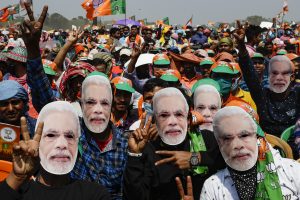India is on the verge of a crucial round of state elections that will both shape the future course of national politics, as well as test the limits of the nation’s all conquering political brand, that of Prime Minister Narendra Modi. The five states spanning eastern and southern India – West Bengal, Assam, Tamil Nadu, Kerala, and Puducherry – seat a fifth of the members of the Lok Sabha (the lower house of parliament) in India. Through his deep personal involvement, Modi has staked his reputation in the elections of these states, especially in Bengal and Assam. A disastrous performance for the Bharatiya Janata Party (BJP) would not just galvanize an opposition already emboldened by the farmer protests, but it would also reinforce the notion that the larger-than-life persona of Modi can be cut down into a more resistible human form.
For now, Brand Modi seems to have escaped into the political stratosphere, untouched by the conventional laws of political competition. It remains near the peak of its appeal, undiminished by a series of recent crises, each of which might have felled lesser leaders. It has emerged largely unscathed from the pandemic that devastated an economy already teetering under a long slowdown. It has weathered a migrant crisis that left millions of Indian workers stranded on the streets because of a ham-fisted sudden lockdown. Through both the anti-Citizenship Amendment Act protests and the farmer protests, as well as the long border crisis with China, Modi has managed to maintain his visceral hold on the public imagination. The brand remains valuable.
In March 2021, as his government was facing prolonged farmer unrest in large parts of northern India, Modi named the world’s largest cricket stadium after himself. Similarly, last year, when India was in the midst of its worst recession in decades, Modi started the construction of a spectacular new parliament building. To those not attuned to India’s new political realities, these extraordinary acts might seem like the suicidal hubris of a leader hopelessly out of touch with his electorate. But to the political brand of Modi, these represented crowning triumphs.
Modi’s ambition is no less than to be seen as India’s most transformative political leader post-independence, the architect of a “new India.” In his own words, the “new Parliament will prove to be a testament to a new and atma-nirbhar (self-reliant) India.” Therefore, just as most Indian public places carry the names of Nehru and Gandhi, the symbols of the old India, it is fitting that the grand monuments of new India should carry the name of its most powerful symbol. This is what Modi wished to convey, with an unabashed confidence that might have eluded him even five years back.
Even as Modi retains one of the most powerful and resilient political brands in global politics, his international image has reached its lowest point. His increasing resort to authoritarian tactics, most recently over the mass farmer protests, has meant that Modi is now more often bracketed in the international media with the strongmen leaders of Russia, Brazil, Hungary, and Turkey. The latest Freedom House Index designated India, for the first time in three decades, as only “partly free.”

































